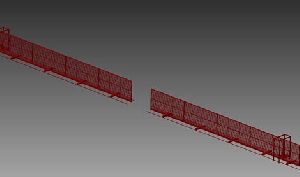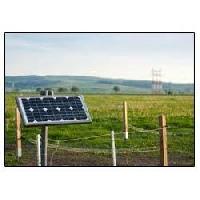
Electromechanical Large Sliding Gates
Get Price Quote
We are also into design and manufacturing of Electromechanical Large Sliding Gates for Air force Runways. Recently we have received an order for design and supply of Electromechanical Motorized Steel Sliding Gate of size 50m(L) x 3mtrs(H).

Fencing Wire
Get Price Quote
Fencing Wire, Fosroc Waterproofing Chemical, Vdf flooring iOS flooring
Best Deals from Fencing Materials

Barbed Wire
Get Price Quote
Barbed wire, also known as barb wire (and frequently in dialect form spelled bob or bobbed), is a type of fencing wireconstructed with sharp edges or points arranged at intervals along the strand(s). It is used to construct inexpensive fences and is used atop walls surrounding secured property. It is also a major feature of the fortifications in trench warfare (as a wire obstacle). A person or animal trying to pass through or over barbed wire will suffer discomfort and possibly injury. Barbed wire fencing requires only fence posts, wire and fixing devices such as staples. It is simple to construct and quick to erect by an unskilled person. It was first conceived in 1865 by Louis Jannin as fil de fer barbelé, French for "barbed iron wire". Joseph F. Glidden ofDeKalb, Illinois received a patent for the modern invention in 1874. Barbed wire was the first wire technology capable of restraining cattle. Wire fences were cheaper to erect than their alternatives and when they became widely available in the United States in the late 19th century they made it affordable to fence much larger areas than before. They made intensive animal husbandry practical on a much larger scale. The most important and most time-consuming part of a barbed wire fence is constructing the corner post and the bracing assembly. A barbed wire fence is under tremendous tension, often up to half a ton, and so the corner post's sole function is to resist the tension of the fence spans connected to it. The bracing keeps the corner post vertical and prevents slack from developing in the fence. Brace posts are placed in-line about 8 feet (2.4 m) from the corner post. A horizontal compression brace connects the top of the two posts, and a diagonal wire connects the top of the brace post to the bottom of the corner post. This diagonal wire prevents the brace post from leaning, which in turn allows the horizontal brace to prevent the corner post from leaning into the brace post. A second set of brace posts (forming a double brace) is used whenever the barbed wire span exceeds 200 feet (60 m). If an 8" post is * feet in length is driven four feet into the ground the brace post assembly can be omitted. When the barbed wire span exceeds 650 ft (200 m), a braced line assembly is added in-line. This has the function of a corner post and brace assembly but handles tension from opposite sides. It uses diagonal brace wire that connects the tops to the bottoms of all adjacent posts. Line posts are installed along the span of the fence at intervals of 8 to 50 ft (2.5 m to 15 m). An interval of 16 ft (5 m) is most common. Heavy livestock and crowded pasture demands the smaller spacing. The sole function of a line post is not to take up slack but to keep the barbed wire strands spaced equally and off the ground. Once these posts and bracing have been erected, the wire is wrapped around one corner post, held with a hitch (a timber hitch works well for this) often using a staple to hold the height and then reeled out along the span of the fence replacing the role every 400 m . It is then wrapped around the opposite corner post, pulled tightly with wire stretchers, and sometimes nailed with more fence staples, although this may make readjustment of tension or replacement of the wire more difficult. Then it is attached to all of the line posts with fencing staples driven in partially to allow stretching of the wire. It is installed from the top down. There are several ways to anchor the wire to a corner post: Hand-knotting. The wire is wrapped around the corner post and knotted by hand. This is the most common method to attaching wire to a corner post. A timber hitch works well as it stays better with wire than with rope. Crimp sleeves. The wire is wrapped around the corner post and bound to the incoming wire using metal sleeves which are crimped using lock cutters. This method should be avoided because while sleeves can work well on repairs in the middle of the fence where there is not enough wire for hand knotting, they tend to slip when under tension. Wire vise. The wire is passed through a hole drilled into the corner post and is anchored on the far side. Wire wrap. The wire is wrapped around the corner post and wrapped onto a special, gritted helical wire which also wraps around the incoming wire, with friction holding it in place. Barbed wire for agriculture use is typically double-strand 12½-gauge, zinc-coated (galvanized) steel and comes in rolls of 1320 ft (402 m) length. Barbed wire is usually placed on the inner (pasture) side of the posts. Where a fence runs between two pastures livestock could be with the wire on the outside or on both sides of the fence. Galvanized wire is classified into three categories; Classes I, II, and III. Class I has the thinnest coating and the shortest life expectancy. A wire with Class I coating will start showing general rusting in 8 to 10 years, while the same wire with Class III coating will show rust in 15 to 20 years. Aluminum-coated wire is occasionally used, and yields a longer life. Corner posts are 6 to 8 inches (15 to 20 cm) in diameter or larger, and a minimum 8 feet (2.4 m) in length may consist of treated wood or from durable on-site trees such as osage orange, black locust, red cedar, or red mulberry, also railroad ties, telephone, and power poles are salvaged to be used as corner posts(poles and railroad ties were often treated with chemicals determined to be an environmental hazard and cannot be reused in some jurisdictions). In Canada spruce posts are sold for this purpose. Posts are driven at least 4 feet (1.2 m) and may be anchored in a concrete base 20 inches (50 cm) square and 42 inches (105 cm) deep. Brace posts are a minimum 4 inches (10 cm) in diameter and are anchored in a concrete base 20 inches (50 cm) square and 24 inches (60 cm) deep. Iron posts, if used, are a minimum 2½ inch (64 mm) in diameter. Bracing wire is typically smooth 9-gauge. Line posts are set to a depth of about 30 inches (75 cm). The main advantage of steel posts is that they can be driven with a post moll or a cylindrical tube closed at one end with plate steel for weight, and pulled out by hand as opposed to wooden posts which must be pounded with a hydraulic pounder and often pulled with a front end loader. Conversely steel posts are not as stiff as wood and wires are fastened with slips along fixed teeth which means variations in driving height effect wire spacing. During the First World War, screw pickets were used for the installation of wire obstacles; these were metal rods with eyelets for holding strands of wire, and a corkscrew-like end that could literally be screwed into the ground rather than hammered, so that wiring parties could work at night near enemy soldiers and not reveal their position by the sound of hammers.Barbed wire, also known as barb wire (and frequently in dialect form spelled bob or bobbed), is a type of fencing wireconstructed with sharp edges or points arranged at intervals along the strand(s). It is used to construct inexpensive fences and is used atop walls surrounding secured property. It is also a major feature of the fortifications in trench warfare (as a wire obstacle). A person or animal trying to pass through or over barbed wire will suffer discomfort and possibly injury. Barbed wire fencing requires only fence posts, wire and fixing devices such as staples. It is simple to construct and quick to erect by an unskilled person. It was first conceived in 1865 by Louis Jannin as fil de fer barbelé, French for "barbed iron wire". Joseph F. Glidden ofDeKalb, Illinois received a patent for the modern invention in 1874. Barbed wire was the first wire technology capable of restraining cattle. Wire fences were cheaper to erect than their alternatives and when they became widely available in the United States in the late 19th century they made it affordable to fence much larger areas than before. They made intensive animal husbandry practical on a much larger scale. The most important and most time-consuming part of a barbed wire fence is constructing the corner post and the bracing assembly. A barbed wire fence is under tremendous tension, often up to half a ton, and so the corner post's sole function is to resist the tension of the fence spans connected to it. The bracing keeps the corner post vertical and prevents slack from developing in the fence. Brace posts are placed in-line about 8 feet (2.4 m) from the corner post. A horizontal compression brace connects the top of the two posts, and a diagonal wire connects the top of the brace post to the bottom of the corner post. This diagonal wire prevents the brace post from leaning, which in turn allows the horizontal brace to prevent the corner post from leaning into the brace post. A second set of brace posts (forming a double brace) is used whenever the barbed wire span exceeds 200 feet (60 m). If an 8" post is * feet in length is driven four feet into the ground the brace post assembly can be omitted. When the barbed wire span exceeds 650 ft (200 m), a braced line assembly is added in-line. This has the function of a corner post and brace assembly but handles tension from opposite sides. It uses diagonal brace wire that connects the tops to the bottoms of all adjacent posts. Line posts are installed along the span of the fence at intervals of 8 to 50 ft (2.5 m to 15 m). An interval of 16 ft (5 m) is most common. Heavy livestock and crowded pasture demands the smaller spacing. The sole function of a line post is not to take up slack but to keep the barbed wire strands spaced equally and off the ground. Once these posts and bracing have been erected, the wire is wrapped around one corner post, held with a hitch (a timber hitch works well for this) often using a staple to hold the height and then reeled out along the span of the fence replacing the role every 400 m . It is then wrapped around the opposite corner post, pulled tightly with wire stretchers, and sometimes nailed with more fence staples, although this may make readjustment of tension or replacement of the wire more difficult. Then it is attached to all of the line posts with fencing staples driven in partially to allow stretching of the wire. It is installed from the top down. There are several ways to anchor the wire to a corner post: Hand-knotting. The wire is wrapped around the corner post and knotted by hand. This is the most common method to attaching wire to a corner post. A timber hitch works well as it stays better with wire than with rope. Crimp sleeves. The wire is wrapped around the corner post and bound to the incoming wire using metal sleeves which are crimped using lock cutters. This method should be avoided because while sleeves can work well on repairs in the middle of the fence where there is not enough wire for hand knotting, they tend to slip when under tension. Wire vise. The wire is passed through a hole drilled into the corner post and is anchored on the far side. Wire wrap. The wire is wrapped around the corner post and wrapped onto a special, gritted helical wire which also wraps around the incoming wire, with friction holding it in place. Barbed wire for agriculture use is typically double-strand 12½-gauge, zinc-coated (galvanized) steel and comes in rolls of 1320 ft (402 m) length. Barbed wire is usually placed on the inner (pasture) side of the posts. Where a fence runs between two pastures livestock could be with the wire on the outside or on both sides of the fence. Galvanized wire is classified into three categories; Classes I, II, and III. Class I has the thinnest coating and the shortest life expectancy. A wire with Class I coating will start showing general rusting in 8 to 10 years, while the same wire with Class III coating will show rust in 15 to 20 years. Aluminum-coated wire is occasionally used, and yields a longer life. Corner posts are 6 to 8 inches (15 to 20 cm) in diameter or larger, and a minimum 8 feet (2.4 m) in length may consist of treated wood or from durable on-site trees such as osage orange, black locust, red cedar, or red mulberry, also railroad ties, telephone, and power poles are salvaged to be used as corner posts(poles and railroad ties were often treated with chemicals determined to be an environmental hazard and cannot be reused in some jurisdictions). In Canada spruce posts are sold for this purpose. Posts are driven at least 4 feet (1.2 m) and may be anchored in a concrete base 20 inches (50 cm) square and 42 inches (105 cm) deep. Brace posts are a minimum 4 inches (10 cm) in diameter and are anchored in a concrete base 20 inches (50 cm) square and 24 inches (60 cm) deep. Iron posts, if used, are a minimum 2½ inch (64 mm) in diameter. Bracing wire is typically smooth 9-gauge. Line posts are set to a depth of about 30 inches (75 cm). The main advantage of steel posts is that they can be driven with a post moll or a cylindrical tube closed at one end with plate steel for weight, and pulled out by hand as opposed to wooden posts which must be pounded with a hydraulic pounder and often pulled with a front end loader. Conversely steel posts are not as stiff as wood and wires are fastened with slips along fixed teeth which means variations in driving height effect wire spacing. During the First World War, screw pickets were used for the installation of wire obstacles; these were metal rods with eyelets for holding strands of wire, and a corkscrew-like end that could literally be screwed into the ground rather than hammered, so that wiring parties could work at night near enemy soldiers and not reveal their position by the sound of hammers.

Exclusive Line VIP Swing Gates
Get Price Quote

Slide Gate
Get Price Quote
Viswakirti Designed for positive control of material discharge from chutes , bins, hoppers. Self-cleaning gate is non-clogging, closes completely to prevent trickling. Available in manual, air or motor-operated models to fit square chutes. Rugged construction.

Solar Fencing System
Get Price Quote
Solar Fencing System, Automatic Power Factor Control Panels, Transformers

Solar Fencing
Get Price Quote
Solar Fencing, organic solar cells, solar ad lights, solar reading lights

Solar Fencing
Get Price Quote
Solar Fencing, Solar Lights, Solar Modules, Solar Cells, Eva Resin

Wire Fencing
Get Price Quote
Wire Fencing, solar water heating equipment, Solar Inverter, Solar Lanterns

solar fencings
Get Price Quote
solar fencings, Solar Power Plants, SOLAR PANELS, solar structures

Solar Fencing
Get Price Quote
Solar Fencing, solar panal, Solar Lanterns, Solar Home Lighting Systems

GI Chain Link Wire Mesh
Get Price Quote
GI Chain Link Wire Mesh, Gi Chain Link Fencing, Construction Wire Mesh Panel

Solar Power Fencing
Get Price Quote
Solar Power Fencing, Solar Photovoltaic Modules, Solar Power System

Solar Power Fencing
Get Price Quote
Solar Power Fencing, Solar Lanterns, Solar Home Ups, Solar Water Heaters

Barbed Wire
Get Price Quote
Barbed Wire, Wire Products

Automatic Gate
Get Price Quote
Automatic Gate, Sliding Gate, Fitness Equipment, Hand Held Metal Detector

industrial fencing
Get Price Quote
industrial fencing

Solar Fencing
Get Price Quote
Solar Fencing, Solar Home Lighting System, Solar Water Heater, wind energy

Gates
Get Price Quote
Gates, Doors, Aluminum Bathroom Door, Revolving Doors, oak door